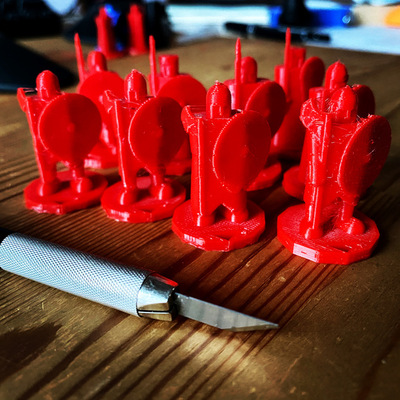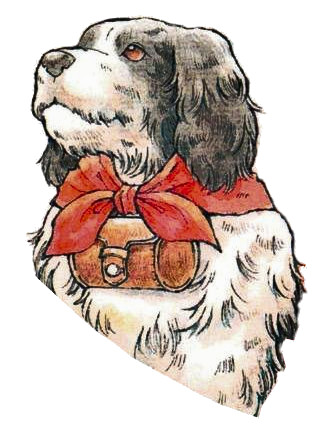
|
Dogs of Yesteryear |
| 2022-05-11 |
Dogs of Yesteryear

Many kinds of dogs guarded homes, businesses, and even cathedrals, Rawcliffe writes. Large, well-trained “house hunds” were so prized as guards that Scottish law required anyone who killed one of them to stand watch in their place for the next year.
The most valuable guard dogs were mastiffs, the breed used to protect London Bridge. Caius described them as “vaste, huge, stubborn, ougly, and eager,” capable of striking “feare and terror” with their “bigge barcking.”
(...)
Among the commoner ranks, some dogs had jobs turning spits in kitchens, using a wheel to rotate the meat over a fire. All sorts of dogs, generally of the lower-class varieties, acted as guide dogs. Others did tricks to earn money for “theyr vagabundicall masters.”
The Hardworking Dogs of Medieval Europe,
which points at Caius' Of Englishe Dogges
Why did I fish this article on medieval dogs? Well, I was considering long rest rules and their assumption that a watch tour of 2 hours is ok. What if watch dogs were used instead?
Somehow I searched for "medieval guard dogs". After reading the following passage in Wikipedia, I realized I should have searched for "medieval watch dogs".
Both guard dogs and watchdogs bark loudly to alert their owners of an intruder's presence and to scare away the intruder. The watchdog's function ends here; a guard dog is then capable of attacking and/or restraining the intruder.
❦
But I anyway found pieces on the place of the "working" dog in the medieval society.
He should, says a 14th-century writer, be courteous and not too fierce ‘wel folowing his maistre and doyng whatever he hym commandeth, he shuld be good and kyndly and clene, glad and joyful and playeng, wel willyng and goodly to all maner folkes save to the wild beestis’
(...)
The average man’s dog, however, earned his keep. In a society with no police and plenty of lawless characters, the watch dog had an important place. For maximum efficiency he was supposed to be shut up by day to sleep so as to be fully on guard at night. Many guardians were simply big dogs, but the most highly regarded were usually mastiffs (something like their modern descendants) or alaunts.
(...)
They were capable of holding an escaped ox, which made them the obvious choice for bull-baiting. They had a reputation for ferocity and contemporary illustrations often show them carefully muzzled. Shepherds and swineherds, of course, had to have dogs, but they were of no well-defined type and were as much for protection against thieves and wolves as for herding.
The text that follows differentiates between the wild dog, the auxiliary dog, and the pet dog. I was hoping to find more content about the auxiliary dog, but no. Fortunately, the wild dog chapter was a good enough consolation prize. Below are my findings about "guard".
The master Culann exclaims, “My life is a waste, and my household like a desert, with the loss of my hound! He guarded my life and my honor…a valued servant, my hound, taken from me. He was shield and shelter for our goods and herds. He guarded all our beasts, at home or out in the fields.”
(...)
After Cúchulainn hears how upset Culann is over the loss of his hound, Cúchulainn offers to take up the role that the dead guard dog left behind, saying, “I will be your hound, and guard yourself and your beasts.”
(...)
The pet dog is being carefully handed over, which is in stark contrast to the dog in the bottom, right-hand corner, walking beneath the wheels of the carriage, completely ignored. This is probably an auxiliary dog meant for guarding the carriage and its contents.
❦
Then, what of our games?
Mastiffs are impressive hounds prized by Humanoids for their loyalty and keen Senses. Mastiffs can be trained as guard dogs, hunting dogs, and war dogs. Halflings and other Small Humanoids ride them as Mounts.
In Old-School Essentials, I could find stats for hunting dogs, war dogs and wild dogs. In For Gold & Glory, the hunting dog goes for 17 gold pieces, the war dog for 20, and the guard dog for 25. What does this premium for the guard dog indicates?
According to the texts referenced above, there are hunting treaties left that include explanations on how to raise and care hunting dogs, but I couldn't find any mention of an equivalent for watch dogs or guard dogs.
Anyway, we don't need to know how to train those dogs, we could simply assume that characters get them as part of their starting equipment, or they acquire them later on, but a period of off-adventure "attunement" is necessary. Probably a check is necessary to determine if the time invested in the animal pays off and it performs as expected.
If an adventuring party has one or two watchdogs, the immediate benefit would be to ensure long rests are not sliced by watch duty and are fully restorative.
Watch dogs could be invaluable for parties, especially when wounds are incurred and rest is necessary. Such dogs would better be trained not to engage in combat, but they could deter move on the flanks of the party and even give a malus on the morale rolls of the opponents.
Speaking of opponents, they too could align watch dogs, guard dogs, hunting dogs, and war dogs, and suddenly you are opposing more complex weapon system.
it would be interesting to investigate how magic and dogs can be combined.
Let me end by quoting Symbaroum's Monster Codex:
Unlike the increasingly common battle-trained jakaars, the regular guard dog is more focused on detecting and warning of threats than attacking the intruders. Practically every Ambrian who has something of value (a business, plantation, antiques, or a sum of thaler) keeps a trained guard dog, whether they are based in the countryside or in a larger settlement.
(...)
Tactics: Guard dogs often work in pairs, helping each other to keep an eye on the area they are supposed to guard. When intruders show up, they initially bark, then try to keep the enemy busy until reinforcements arrive.
